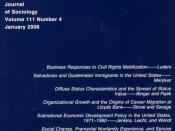Introduction:The article explores how work group sex composition influences men and women and how this affects firm - performance. Past researches indicated that demographic similarities yielded improved financial performance (Byrne, 1971) yet the recent findings estimate that women expressed a greater likelihood of gender diversity than men. This paper is the first to explain why variations in work group sex composition might affect men and women differently while previous research findings may only seem to fit similarity-attraction predictions based on limited samples.
Theory/Hypotheses:The theories of Status expectations and Similarity-attraction underpin the study's hypotheses. Kanter's (1977) idea that men and women will be similarly affected by being underrepresented is adapted to hypothesize that both sexes will prefer membership in higher-status work groups. However, they also identified that the likelihood of transferring from current work group is greater by women in female-dominated groups than by men in male-dominated groups. This directed them to think which factors indicate the presence/absence of gender diversity.
On the basis of a categorization scheme, four categories were made - Homogeneous, Same Sex Dominates, Balanced and Other Sex dominates. In this manner, they hypothesized that factors like Work group cooperation, Positive affect and Normative commitment to the organization drew out different results in each category.
Methodology:The research uses reliable, high-quality, primary data collected through survey of employees to capture their preferences. The researchers use a "quantitative approach in empirical testing using statistical techniques" (Martins, et. al., 1999); however a qualitative strategy is adopted for deriving Dependent Variables by selecting the extent to which the respondents agreed with each statement. They used Caldwell, Chatman, and O'Reilly's (1990) eight-item scale to assess Normative commitment, measured Positive affect using the ten-item scale from the PANAS and constructed a five item scale to measure Work group cooperation. Causality shows presence/absence of gender...


